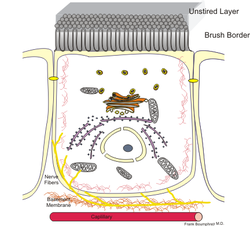Enterocyte
A enterocyte (of gr. Έντερον "gut" and κύτος "cell"; the Germans Saumzelle ) is by far the most common cell of the small intestine epithelium , and as such for the absorption in charge of different substances from the diet. Enterocytes are also located in the large intestine . An enterocyte is a highly prismatic epithelial cell about 20 μm in height and a characteristic, apical brush border membrane with about 1 μm long microvilli . These cause an enormous increase in the surface and thereby enable the resorptive abilities.
Towards the lumen , the enterocytes are surrounded by a glycoprotein structure, the glycocalyx , about 500 nm thick . They are connected to one another by tight junctions , which form a tight barrier against the intestinal lumen. Both the apical and the basal membrane contain proteins necessary for active transport.
The various tasks of the enterocytes include:
- Resorption of small-molecule food components ( sugar , amino acids , fats or fatty acids , vitamins ),
- active ion transport (e.g. sodium , calcium , magnesium , iron ),
- Water absorption,
- Resorption of bile acids ( enterohepatic circulation ),
- Secretion of immunoglobulins (IgA).
To enable the transport of substances through the cell, enterocytes have numerous specialized membrane proteins , such as B. Hephestine and Ferroportine .

Enterocytes get much of their energy from butyrate produced by probiotics. This alternative of energy supply is favored by a fiber-rich food, whose water-soluble fiber (e.g. pectin, inulin) serves as a nutrient for the intestinal bacteria.
Individual evidence
- ↑ H. Böhles: Aspects of the trophic effects of food ingredients on the intestinal wall. In: Monthly Pediatrics. Volume 146, Supplement 1, August 1998, pp. S57-S62
